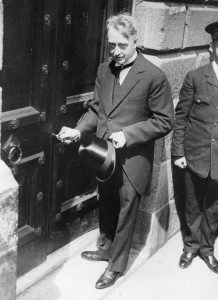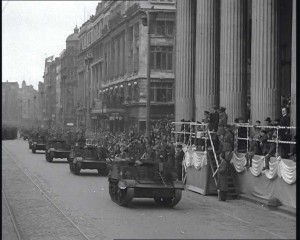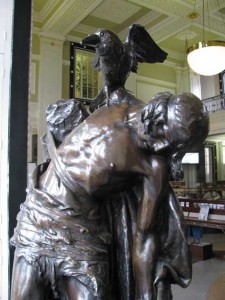Easter Rising commemorations in the early Irish state
Published in Features, Issue 2 (March/April 2016), Revolutionary Period 1912-23, Volume 24‘IS IT STILL HELD THAT THE GOVERNMENT IS NOT MAKING IT A PARTY DEMONSTRATION?’—RICHARD MULCAHY, EASTER 1935
By Allison Martin

W.T. Cosgrave officially opening the newly restored GPO in July 1929. In an eloquent speech he commented on ‘the radically altered political landscape’ and emphasised that ‘the Irish nation was progressing in the path of peace’. (Getty Images)
The 1920s and the restoration of the GPO
In common with today’s Irish government, one of the many issues facing the Cumann na nGaedheal administration was how the anniversary of the Easter Rising should be approached. Despite the fact that W.T. Cosgrave, president of the Executive Council, along with other prominent members of the party like Richard Mulcahy, had fought during the Rising, the government was eager to keep the commemoration ceremonies low-key.
The first official state commemoration was held at Arbour Hill in 1924 and proved to be somewhat of an embarrassment, as the widow of Michael Mallin was the only relative of the executed leaders who attended. After Fianna Fáil was formed in 1926, the government was put under even more pressure, as competing ceremonies were held by rival parties. When the restoration of the General Post Office was completed in July 1929, the government held an in-auguration ceremony, inviting the people who usually attended the annual service at Arbour Hill. During this event a small number of armed troops marched past the building and the tricolour was raised.
Cosgrave has often been characterised as a taciturn leader, but he made use of this opportunity to reflect on the achievements of his government and to present the Irish Free State in a positive light. In an eloquent speech outside the GPO, he commented on ‘the radically altered political landscape’ and emphasised that ‘the Irish nation was progressing in the path of peace’. This event took place just a few months before the Wall Street Crash and Cosgrave was keen to project an image of a modern, prosperous Irish nation. In another carefully staged move he made the first phone call from the GPO, thus demonstrating that the Free State had embraced advances in modern communications. It was only at the end of the speech that the actual events of the Rising were mentioned. Given that Cosgrave’s party had the unenviable task of state-building and reconstruction in the aftermath of the Civil War, the relative emphases are unsurprising.
Nineteenth anniversary—pageantry and symbolism
Cosgrave’s government may have had some reservations about celebrating the Rising but the succeeding de Valera government had no such qualms. The 1935 commemoration was carefully choreographed in order to present Fianna Fáil as the sole custodian of the 1916 legacy. Despite the fact that the nineteenth anniversary was a date without any particular numerical significance, the government insisted on hosting a relatively large commemoration. On Easter Sunday a re-enactment of the insurrection took place. The ‘republic’ was declared once again and 2,500 veterans of the Rising lined up outside the GPO. According to James Moran,
‘… the 1935 memorial service echoed the anniversary celebration of Russia and France, where post-revolutionary governments re-staged the symbolic battles of the past for modern political advancement’.

De Valera taking the salute at the 1916 silver jubilee commemorations in 1941 outside the GPO. The overtly militaristic nature of the parade projected an image of military strength in the face of threats to Ireland’s neutrality. (British Pathé)
Members of the opposition were only too aware that Fianna Fáil was attempting to use the commemoration in order to gain political capital. In the Dáil, Fine Gael’s Richard Mulcahy asked angrily, ‘Is it still held that the government is not making it a party demonstration?’ Interestingly, David Fitzpatrick has asserted that by this stage ‘neither Fianna Fáil or any other party had yet managed to secure sole custody of the Easter legacy’. It was not for lack of trying.
De Valera clearly attempted to fashion the 1935 ceremony to reflect his vision for the Irish Free State. He was eager to reinforce the image of the new state as conservative and predominantly Catholic. With this in mind, he insisted that members of the Catholic clergy should play an important role in the ceremony. Consequently, on Easter Sunday eight priests stood on the platform outside the GPO. Two open-air Masses were also held, one outside Portobello Barracks and the other at the GPO. The majority of the insurgents had been Catholic, but Patrick Pearse’s concept of the blood sacrifice hardly corresponded with the Vatican’s teachings on suicide. De Valera was an astute politician and would have been aware that this overtly religious ceremony would help to consolidate the relationship between Fianna Fáil and the Catholic Church. By surrounding himself with members of the Catholic clergy on Easter Sunday, de Valera hoped to put an end to any doubts about the party’s piety, especially in the light of the excommunication of some republicans during the Civil War.
Selective memorialisation
Political figures are often keen to emphasise certain aspects of a past historical event whilst conveniently ignoring others that may raise awkward questions for the party concerned. This was clearly the case during the 1935 ceremony. Despite the fact that the leaders of the Rising had been committed to social change, de Valera was careful to avoid any mention of social issues during the commemoration. Significantly, when he unveiled the statue of Cuchulainn it became apparent that only the third paragraph of the Easter Proclamation had been inscribed on the monument. This particular paragraph focused on the national struggle rather than social struggle. James Moran has suggested that in 1935 the government used the anniversary of the Rising in order to deflect attention away from the shortcomings of the party’s domestic policies. By this stage Fianna Fáil had been in power for three years, but despite the party’s electoral promises the Irish people still faced many hardships. Moreover, the Irish Free State was engaged in a trade war with Britain. It could therefore be argued that the re-staging of the Rising was a deliberate attempt by the Irish government to distract people from their everyday concerns. W.T. Cosgrave, who was now the leader of the opposition, warned his rivals that ‘it is not possible to hide these national limitations today or to cover them with a veil lifted from the bronze statue of Cuchulainn’.

Oliver Sheppard’s statue of Cuchulainn. At its unveiling in the GPO in 1935 Éamon de Valera was careful to avoid any mention of social issues and, significantly, only the third paragraph of the Proclamation, focused on the national struggle, was inscribed on the base. (Paula Murphy)
By the time of the silver jubilee of the Rising in 1941 the international situation had changed drastically. At first de Valera was rather reluctant to hold a large ceremony, as he was aware that such a celebration could be deemed inappropriate in the midst of the Emergency. When Easter Sunday came, however, the military parade went ahead and was even grander than before. The parade included units of the army, members of the Old IRA and the emergency services. Given that de Valera had decided on a policy of neutrality, the overtly militaristic nature of the parade is somewhat surprising. Clearly, though, it was not just commemorating 1916 that was on the government’s mind. At this particular time the state faced many external threats, not least from Nazi Germany. De Valera and his administration therefore decided to use the commemoration service in order to project an image of military strength. In reality, the Irish state was militarily and financially unprepared for war. Nevertheless, the impressive military procession had the desired effect: one reporter from the Irish Independent was left with the distinct impression that ‘the nation was prepared’; another from the Irish Press stated that the parade ‘was much more than a mere commemoration. It was the case of Ireland stated.’
The anniversary of the Rising provided the government with a convenient opportunity to reiterate that Éire was an independent state capable of making her own decisions. As has been the case with many other Easter Rising commemorative services, the government was accused of using the ceremony for its own advantage in 1941. Behind the impressive military parade may well have been an attempt to boost support for the government at a time when unemployment and rural poverty were sweeping the nation.
Alison Martin holds an MA in Irish History from Queen’s University, Belfast.
Further reading
I. McBride (ed.), History and memory in modern Ireland (Cambridge, 2001).
M. McCarthy, Ireland’s 1916 rising: explorations of history-making, commemoration and heritage in modern times (Surrey, 2012).
J. Moran, Staging the Easter Rising: 1916 as theatre (Cork, 2005).
C. Wills, That neutral island: a cultural history of Ireland during the Second World War (London, 2007).
















